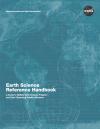You are here
Science Communication Material
NASA's Earth Observing System provides a variety of materials available for download. Feel free to choose a category below:
- Brochures
- Postcards
- Posters
- Science Writers’ Guide
- Mission Brochures
- Fact Sheets
- Calendars
- Booklets
- Lithographs
- Reference and Data Products Handbooks
- iBooks
- Activities
 |
Sea Ice This card introduces the subject of the seasonal cycles of sea ice in the Arctic and Antarctic polar climate systems. This publication appears in: |
 |
2006 Earth Science Reference Handbook Revised May 2006: The Earth Science Reference Handbook provides a guide to the satellite missions and other elements of NASA's Earth science program. This volume updates the 1999 EOS Reference Handbook, now that the major missions of the Earth Observing System (EOS) have been launched and are transmitting data, and broadens the coverage to include not just EOS but also additional NASA Earth science missions. This publication appears in: |
 |
Earth by Day, Earth by Night See where urban populations of the developed world are concentrated around the globe. Compare Earth’s daytime map of the continents with a compelling global view of Earth’s city lights at night. This publication appears in: |
 |
NASA's Science Mission Directorate NASA determines Earth’s place in the universe. This publication appears in: |
 |
CALIPSO/CloudSat/GRACE This publication is intended to be a one-stop resource for science writers and reporters who want to write about any of these three missions. For each satellite, the guide includes a quick reference sheet, Q&A, basics on the science of each mission, public affairs and scientist contact information, explanations of the satellites and their instruments, Web sites and other resources. This is related to the following mission(s):
This publication appears in:
|
 |
CloudSat and CALIPSO Informational brochure on NASA’s CloudSat and CALIPSO satellites. This is related to the following mission(s): This publication appears in: |
 |
The Balance of Power in the Earth-Sun System The Sun is the major source of energy for Earth’s oceans, atmosphere, land, and biosphere. Averaged over an entire year, approximately 342 watts of solar energy fall upon every square meter of Earth. This publication appears in: |
 |
The Importance of Understanding Cloud One of the most interesting features of Earth, as seen from space, is the ever-changing distribution of clouds. They are as natural as anything we encounter in our daily lives. As they float above us, we hardly give their presence a second thought. And yet, clouds have an enormous influence on Earth’s energy balance, climate, and weather. This publication appears in: |
 |
Aura NASA’s Earth Observing System (EOS) Aura satellite is a NASA mission whose purpose is to study the Earth’s ozone, air quality and climate. This mission is designed specifically to conduct research on the composition, chemistry and dynamics of the Earth’s upper and lower atmosphere employing multiple instruments on a single satellite. This is related to the following mission(s): This publication appears in: |
 |
Aura Aura’s four instruments study the atmosphere’s chemistry and dynamics, and enable us to investigate questions about ozone trends, air quality changes and their linkage to climate change. Aura’s measurements provide accurate data for predictive models and useful information for local and national agency decision support systems. Aura was the third in a series of large Earth observing platforms to be flown by the National Aeronautics and Space Administration (NASA) with international contributions. Aura along with EOS Terra (launched December, 1999) and Aqua (launched May, 2002) provide an unprecedented view of the global Earth system. This is related to the following mission(s): This publication appears in: |
